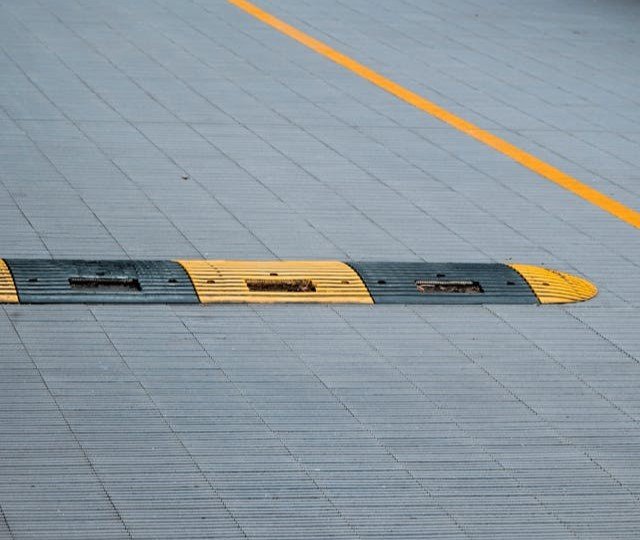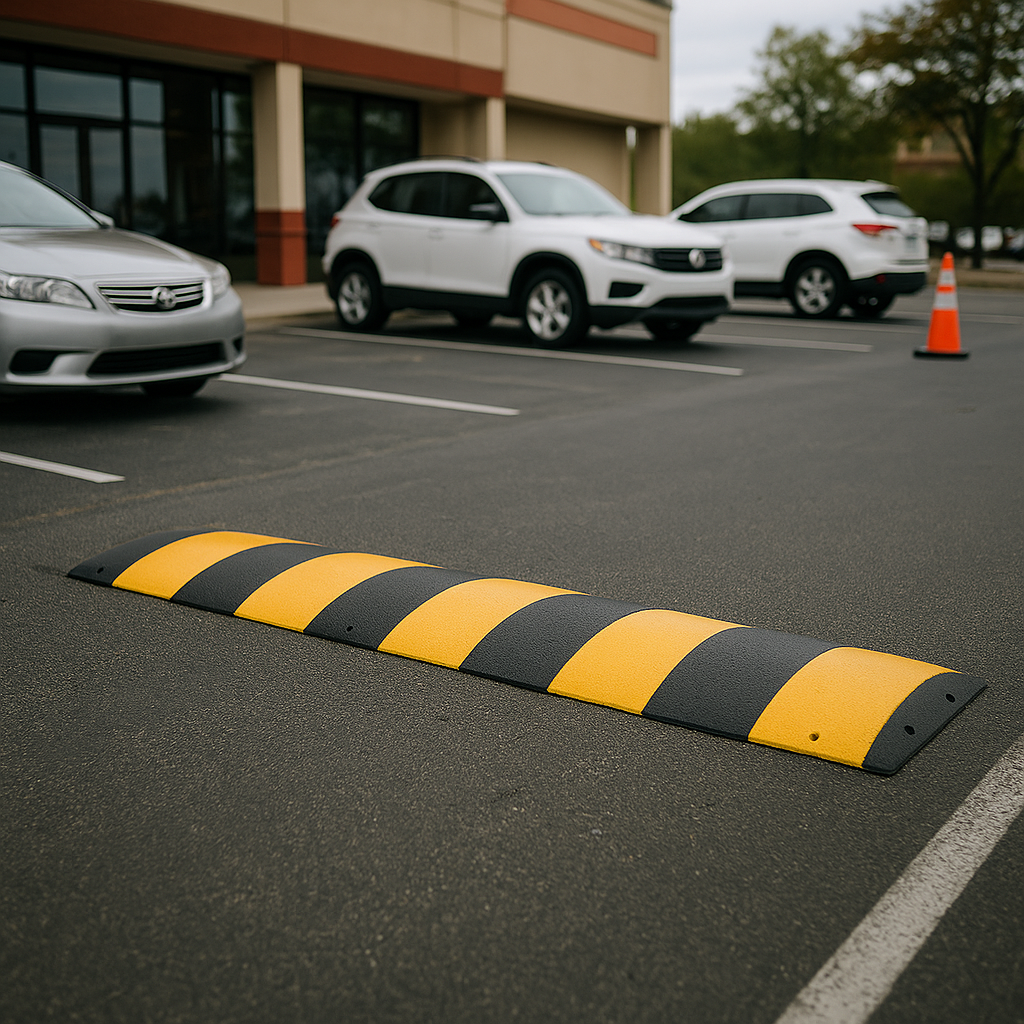For business owners managing commercial, industrial, or private properties, safety is a top priority. One of the simplest and most effective ways to control vehicle speed and reduce accidents is the use of speed bumps. However, installing them isn’t as simple as just placing them where they seem needed. Speed bumps are subject to various compliance requirements depending on location, road ownership, vehicle type, and usage patterns.
Failing to comply with regulations or best practices can lead to liability, fines, or forced removal. This guide walks business owners through the essential compliance steps to properly and legally install speed bumps on their property.

Know Your Property Type
The first step is to determine whether your property qualifies for private or public traffic regulation. The rules differ significantly depending on ownership and access type.
Private Property (Owned and Controlled by Business)
You typically have more control over the installation of speed bumps. This includes private parking lots, loading zones, driveways, and internal roads not used by the public.
Public-Access Roads (Public or Open Access)
Even if on your property, if the road is open to public traffic, local government or transportation authorities may have jurisdiction. Speed bump installation on public-access roads usually requires permits, engineering assessments, and conformance to specific design standards.
Clarify ownership and access level before proceeding. Many non-compliance cases happen because property managers misclassify roads.
Check Local Regulations and Permitting
Each municipality or state can have different requirements related to speed bump installation. These may include:
- Prohibited road types (e.g., emergency vehicle routes)
- Minimum traffic volume thresholds
- Required permit applications
- Notification or approval from local departments
- ADA (Americans with Disabilities Act) compliance
In many cities, installing speed bumps without a permit or against code can lead to citations or mandated removal. Always contact your local traffic or planning department before making a decision.
Understand ADA and Accessibility Rules
Compliance with accessibility laws is critical. Improper installation of speed bumps can violate ADA rules, especially if placed in pedestrian walkways or interfere with accessible routes.
To stay compliant:
- Avoid installing speed bumps on sidewalks or near wheelchair ramps
- Keep adequate spacing from crosswalks and entrances
- Ensure all markings and signage are visible and readable
Review federal and local accessibility guidelines to prevent costly mistakes or legal complaints.
Choose the Right Type Based on Use and Compliance
Speed bumps come in various forms, and using the wrong type may violate local codes or create unintended safety risks. Key factors to consider include:
Height and Width Limits
Most regulations restrict height between 2 to 4 inches and specify width between 12 to 36 inches. Higher bumps may be illegal or dangerous.
Material Type
Local codes may allow only specific materials (e.g., rubber, concrete, or asphalt). For example, some municipalities restrict the use of plastic bumps due to wear concerns.
Spacing Guidelines
Some jurisdictions require minimum spacing between multiple speed bumps to avoid vehicle instability or excessive slowing.
Use pre-approved commercial-grade bumps that meet national traffic safety standards or specific local guidelines for safer and compliant installations.

Ensure Proper Signage and Markings
Without proper warnings, speed bumps can become hazards. Most compliance issues result from poor or missing signage rather than the bump itself.
Standard requirements often include:
- Advance warning signs with clear messages (e.g., “Speed Bump Ahead”)
- Reflective paint or striping on the bump itself
- Signs placed at a regulated distance before the bump
- Illumination for night visibility if the area lacks lighting
Use MUTCD (Manual on Uniform Traffic Control Devices) compliant signs and markings where required.
Placement Considerations for Legal Safety
Strategic placement matters for both effectiveness and compliance. Avoid placing bumps:
- Too close to intersections or stop signs
- On steep grades or inclines
- Where emergency vehicles must pass rapidly
- At driveways or entrance/exit points
Follow guidelines such as placing bumps 150 to 200 feet apart and at least 20 feet from intersections. Always prioritize visibility, driver reaction time, and impact on larger vehicles like trucks or emergency units.
Consider Emergency Vehicle Access
Most cities restrict speed bump use on roads that serve as primary emergency response routes. In industrial parks, gated communities, or business complexes, fire departments often require smooth access.
To avoid issues:
- Consult local emergency services before installing
- Consider speed humps or cushions as alternatives
- Use gaps in the bump design that allow emergency wheels to pass through
If you fail to accommodate emergency access, your installation could be flagged and ordered removed.
Coordinate with Insurance Providers
Insurance companies view traffic calming positively, but only when installed correctly. Before placing speed bumps:
- Inform your insurance provider
- Ask if your policy has any restrictions or coverage limitations
- Confirm that your bump plan supports overall safety strategy
Improper or non-compliant installation can affect claims and coverage if an accident occurs due to the bump.
Document the Installation Process
Maintain clear records of:
- Permit approvals
- Product specifications
- Contractor details (if used)
- Diagrams of placement
- Signage and striping installations
- Inspections or consultations with local departments
Having a documented process helps defend against liability claims or enforcement actions. It also shows that your installation was not careless or negligent.
Consider Maintenance and Inspection Requirements
Compliance doesn’t stop at installation. Speed bumps must be maintained regularly to remain safe and legal.
Include a schedule to:
- Repaint faded markings
- Tighten or replace worn bump sections
- Clean debris buildup
- Replace missing or damaged signs
- Inspect for cracking or degradation
Failure to maintain could make your business liable for damage or injury. Routine inspections and fast repairs show continued compliance and care.
When to Hire a Professional
If your site is large, complex, or open to public traffic, hiring a professional traffic consultant or civil engineer is smart. They can help:
- Assess the best bump locations
- Ensure ADA and code compliance
- File proper permits
- Choose compliant materials and designs
For permanent or large-scale installations, this step is often required and can save time, money, and legal exposure.
Final Thoughts
Installing speed bumps is a smart move for safety, but doing it without understanding the compliance landscape is risky. Business owners must treat it as a regulated infrastructure upgrade, not just a safety add-on.
Follow these key steps:
- Confirm property type and access level
- Check local regulations and permits
- Prioritize ADA and emergency access compliance
- Use approved materials and designs
- Ensure signage and visibility
- Document everything and maintain regularly
Done correctly, speed bumps reduce risk, lower insurance exposure, and protect people and property. Done incorrectly, they invite fines, legal problems, and complaints. Take the compliance side seriously, and your investment in safety will pay off long term.
Looking for a custom Speed Bumps manufacturer or supplier? Struggling to find the right factory to bring your vision to life? We’ve got you covered! At our place, we craft top-quality Speed Bumps with precision and care. Big or small, your needs are our mission. Let’s launch your Speed Bumps project and take your product line to the next level! Click here to contact
